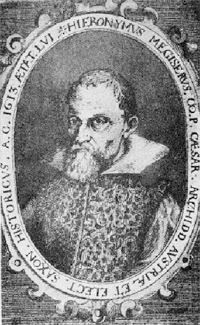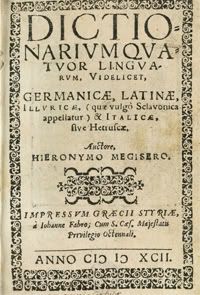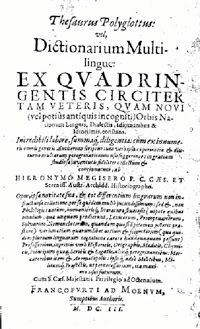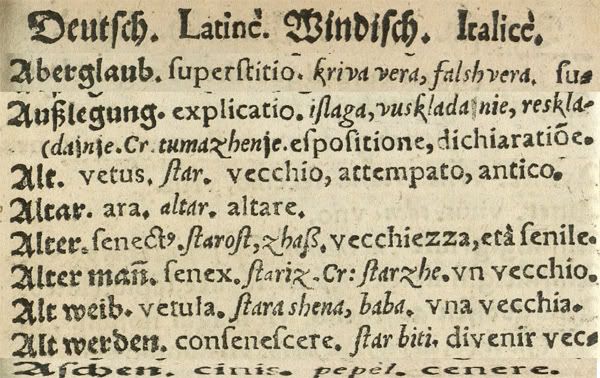Google Translation of work done by Andonov Blagojce
Source: Drazen Budisa Tangra called Macedonian language in 1603 "
Hieronimus Megiser

Hieronymus Megiser (Hieronimus Megiser) (1554/55 - 1618) - is a German teacher, linguist, historian and cartographer. Known in the literary history of Slovenia and Croatia as the first written dictionary where their languages are mentioned along with Latin, German and Italian. Hon. Megiser was born in late 1554 or 1555 in Stuttgart. From 1571 to 1577 he studied in Tuebingen, near the famous humanist and philologist Frishlin Nicodemus. During the study became a close friend of Yuri Dalmatian. In 1581, after vain search for teaching position in his homeland with the help of J. Dalmatian he gets a job as a tutor, private teacher in Fuzhine near Ljubljana. In 1582, Megiser studied law in Padua, and from 1584 to 1588, he again became a private tutor to young noblemen, Jacob and Carl Schuessel and Yuri Hartmann von Shtatenberg. Intensive research trips in 1588 and 1589 in Italy and Malta, he settled in Graz. Shortly thereafter, in 1591 traveled to England, Holland and Germany. During my travels examines the history of nations, cartography and astronomy, and for their achievements in this field he was appointed "Professor of historiography. He met the famous astronomer Johannes Kepler, and brings interest and become good friends. During his trip to Germany, around 1593 he married the daughter of Johann Spais had its printing house in Frankfurt am Main, where some time and lives. Then the next years, from 1593 to 1601, he spent Celovec (Klagenfurt) as director of the Protestant school. Mon strained relations with the Catholic Church, Protestant Megiser was forced to leave Celovec and returned in the Frankfurt am Main. Worked as a professor of history at the University of Leipzig. The needs of Upper Austria, on request, in 1613 he moved to Linz, where he worked as a professional historian as director of the city library. During the narrowing of the Catholic Church and Protestant experiences its peak Hieronimus Megiser died in 1619.
Hieronimus Megiser living and working in an extremely turbulent time under the influence of Italian Humanism, 15 and 16th century, intellectual force in Western and Central Europe to protest against medieval dogma and spiritual poverty which made the medieval Christian church and seek reform in the Catholic Church. Protestantism as a movement to reform the church, peripherally affected the Balkan nations that were under the Austrian Empire. During this period, Protestants from Croatia and Slovenia had to flee Germany. At the same time in Germany prebegnuvaat many people from the territories under Turkish occupation, including the Macedonians.
All of these dissident persons who found protection, foreigners in Germany, he felt like the sons of a Balkan nation. In order to liberate the Balkans from medieval zachmaenost under the restraints of the Catholic priesthood, and the Rostov Turkish, Balkan rebels needed support from the masses. Among them are developed Illyrian idea of forming a opshtobalkanski language "Illyrian language", which should be understood by all Balkan nations, and the basis for their connectivity, as well as establishing a single Illyrian people. For that purpose near Urach Tubingen Illyrian established printing house, where Protestant printed books intended for the whole Balkan area of Trieste to the Black Sea. The books were printed in Cyrillic, Latin and Glagolitic. The idea of a Balkan cultural and political unity never dototash was also placed on clear, specific and strong action program. Megiser as intellectual, linguist and Protestant, even during his studies in Tübingen and later during his stay and work in Graz Fuzhine and well met Balkan languages.
Time studies Hieronimus Megiser in Padua, and his research trips throughout Italy, Malta, Western Europe, philologist, historian, cartographer and astronomer, coincides with the period when the influence of Italian humanism, more spread classical sciences and return to ancient values, study ancient history and philosophy, Greek and others. In this period when Hieronimus Megiser explores the history of the Roman Empire more alive memories of the strong old kingdom of Alexander of Macedon, and appear the names of forgotten ancient Macedonia and Illyria. The printed maps of the Alexandrian astronomer and geographer K. Ptolemy (II century), where the borders of Macedonia were quite accurately marked. Later, the founder of modern scientific cartography Gerardus Mercator (1512-1594) in January created the first map of Macedonia, which was printed at Duisburg in 1589th During this period, between 1584 and 1594, the Balkan heraldry appears first Roll of Peter Ohmuchevich , which appear, arms and Illyria, whose names are not only mentioned, but noted in a prominent place. During this period the name of Macedonia is becoming popular not only for the learned people of Western Europe in general, and learned about people from Croatia, Bosnia, Dalmatia and Dubrovnik Republic in particular.
Hieronimus Megiser a direct witness of the time, in the case of unification and the creation of movement of the Balkan Christians against the Turks. Pope Clement VIII in 1592 wanted to create an alliance against Turkey in which to enter Spain, Austria, Poland and Russia. During this period, Peter Angel, from Thessaloniki, who was expelled by the Turks, requires the German vladatel Rudolph to represent the Pope to protect, then Christian aid Archduke Ferdinand Hapsburg and Pope seeks Ohrid Archbishop and Patriarch Gabriel and ohridokiot Patriarch Athanasia who takes on Spanish and other European rulers and offers to raise the Balkan Christians. In July 1593 Albanian officers he wrote to Pope Clement VIII to the rebel all Albanians against the Turks. The letter that was struck by the following press article: "DZigillum et Regni Macediniae Albaniae".

Overall knowledge Hieronimus Megiser, collected during his research work was later found in his works. Published more works from which the Balkan nations are particularly important dictionaries. As a philologist who rule the good German, Italian, Latin, Slavic languages and others, he published two dictionary: "Dictionarium quatuor linguarum" - Graz, 1592 and "Thesaurus Polyglottus / Dictionarium Multilingue" - Frankfurt, 1603, in their dictionaries, Magiser treats first Slavic language, under the name Illyrian, equally with German, Latin, Italian language, etc. These dictionaries, case for the Balkan nations are especially important isluchitelno Slovenian and Croatian people, but no less for the Macedonian language. In attempts to create a general Balkan languages under common name Illyrian language besides Slovenian and Croatian, are often encountered Macedonian words.
Thus his work in his "Thesaurus Polyglottus / Dictionarium Multilingue", which is very different from the first format, and where the main word in each case is German and Latin language, then the vertical range of words in languages, the problems of interpretation of words in a different style ("Prob einer Verdolmetschung in funfizig unteschiedlichen Spraechen"), makes the distinction of the four main language as a matrix: BOGE equivalent of God, God (in Slavic), GODT German, Deus in Latin and Greek THEUS. For example, the homepage where David has Psalm XXI reads: "My God, why leave me" and was translated into 21 languages of which one of these languages is the Macedonian language or rather makedonisch in German and Latin makedonise the ski are says: "Boge Boge moi vienimi, vesniu me ostavi".

But first chetirijazichen Dictionary of Hieronimus Megiser "Dictionarium quatuor linguarum", published in 1592 in Graz, it becomes much more interesting when considered in terms of the emergence of the Balkan peoples arms at the very beginning of the book, including the Macedonian, as well as the use of Macedonian words. The emergence of the Balkan arms of a small miniature, which he decorated a dictionary at the very beginning, only announce here that are working to establish a general the Balkan languages, as can be seen from the selected various Slavic words (mostly Slovenian and Croatian, then Dalmatian, Macedonian, etc.). ekvivalntni as German, Latin and Italian language.
This chetirijazichen dictionary begins with a German word, followed, Latin, Slavic and Italian.
I will point out several examples where I think he used Macedonian words, but the final court should give the Macedonian language experts, and heraldicharite for the miniature. For example: 1) superstitio - curve faith, 2) explicatio - displayed 3) vetus - old, 4 senectus - age <5 vetula - granny, grandma 6) cinis - ash, dust
Unfortunately for us, very little is written or spoken on this topic. We hope that this gave a small contribution to this issue or posistematichno initiated research in this direction.

Source: Drazen Budisa Tangra called Macedonian language in 1603 "
Hieronimus Megiser

Hieronymus Megiser (Hieronimus Megiser) (1554/55 - 1618) - is a German teacher, linguist, historian and cartographer. Known in the literary history of Slovenia and Croatia as the first written dictionary where their languages are mentioned along with Latin, German and Italian. Hon. Megiser was born in late 1554 or 1555 in Stuttgart. From 1571 to 1577 he studied in Tuebingen, near the famous humanist and philologist Frishlin Nicodemus. During the study became a close friend of Yuri Dalmatian. In 1581, after vain search for teaching position in his homeland with the help of J. Dalmatian he gets a job as a tutor, private teacher in Fuzhine near Ljubljana. In 1582, Megiser studied law in Padua, and from 1584 to 1588, he again became a private tutor to young noblemen, Jacob and Carl Schuessel and Yuri Hartmann von Shtatenberg. Intensive research trips in 1588 and 1589 in Italy and Malta, he settled in Graz. Shortly thereafter, in 1591 traveled to England, Holland and Germany. During my travels examines the history of nations, cartography and astronomy, and for their achievements in this field he was appointed "Professor of historiography. He met the famous astronomer Johannes Kepler, and brings interest and become good friends. During his trip to Germany, around 1593 he married the daughter of Johann Spais had its printing house in Frankfurt am Main, where some time and lives. Then the next years, from 1593 to 1601, he spent Celovec (Klagenfurt) as director of the Protestant school. Mon strained relations with the Catholic Church, Protestant Megiser was forced to leave Celovec and returned in the Frankfurt am Main. Worked as a professor of history at the University of Leipzig. The needs of Upper Austria, on request, in 1613 he moved to Linz, where he worked as a professional historian as director of the city library. During the narrowing of the Catholic Church and Protestant experiences its peak Hieronimus Megiser died in 1619.
Hieronimus Megiser living and working in an extremely turbulent time under the influence of Italian Humanism, 15 and 16th century, intellectual force in Western and Central Europe to protest against medieval dogma and spiritual poverty which made the medieval Christian church and seek reform in the Catholic Church. Protestantism as a movement to reform the church, peripherally affected the Balkan nations that were under the Austrian Empire. During this period, Protestants from Croatia and Slovenia had to flee Germany. At the same time in Germany prebegnuvaat many people from the territories under Turkish occupation, including the Macedonians.
All of these dissident persons who found protection, foreigners in Germany, he felt like the sons of a Balkan nation. In order to liberate the Balkans from medieval zachmaenost under the restraints of the Catholic priesthood, and the Rostov Turkish, Balkan rebels needed support from the masses. Among them are developed Illyrian idea of forming a opshtobalkanski language "Illyrian language", which should be understood by all Balkan nations, and the basis for their connectivity, as well as establishing a single Illyrian people. For that purpose near Urach Tubingen Illyrian established printing house, where Protestant printed books intended for the whole Balkan area of Trieste to the Black Sea. The books were printed in Cyrillic, Latin and Glagolitic. The idea of a Balkan cultural and political unity never dototash was also placed on clear, specific and strong action program. Megiser as intellectual, linguist and Protestant, even during his studies in Tübingen and later during his stay and work in Graz Fuzhine and well met Balkan languages.
Time studies Hieronimus Megiser in Padua, and his research trips throughout Italy, Malta, Western Europe, philologist, historian, cartographer and astronomer, coincides with the period when the influence of Italian humanism, more spread classical sciences and return to ancient values, study ancient history and philosophy, Greek and others. In this period when Hieronimus Megiser explores the history of the Roman Empire more alive memories of the strong old kingdom of Alexander of Macedon, and appear the names of forgotten ancient Macedonia and Illyria. The printed maps of the Alexandrian astronomer and geographer K. Ptolemy (II century), where the borders of Macedonia were quite accurately marked. Later, the founder of modern scientific cartography Gerardus Mercator (1512-1594) in January created the first map of Macedonia, which was printed at Duisburg in 1589th During this period, between 1584 and 1594, the Balkan heraldry appears first Roll of Peter Ohmuchevich , which appear, arms and Illyria, whose names are not only mentioned, but noted in a prominent place. During this period the name of Macedonia is becoming popular not only for the learned people of Western Europe in general, and learned about people from Croatia, Bosnia, Dalmatia and Dubrovnik Republic in particular.
Hieronimus Megiser a direct witness of the time, in the case of unification and the creation of movement of the Balkan Christians against the Turks. Pope Clement VIII in 1592 wanted to create an alliance against Turkey in which to enter Spain, Austria, Poland and Russia. During this period, Peter Angel, from Thessaloniki, who was expelled by the Turks, requires the German vladatel Rudolph to represent the Pope to protect, then Christian aid Archduke Ferdinand Hapsburg and Pope seeks Ohrid Archbishop and Patriarch Gabriel and ohridokiot Patriarch Athanasia who takes on Spanish and other European rulers and offers to raise the Balkan Christians. In July 1593 Albanian officers he wrote to Pope Clement VIII to the rebel all Albanians against the Turks. The letter that was struck by the following press article: "DZigillum et Regni Macediniae Albaniae".

Overall knowledge Hieronimus Megiser, collected during his research work was later found in his works. Published more works from which the Balkan nations are particularly important dictionaries. As a philologist who rule the good German, Italian, Latin, Slavic languages and others, he published two dictionary: "Dictionarium quatuor linguarum" - Graz, 1592 and "Thesaurus Polyglottus / Dictionarium Multilingue" - Frankfurt, 1603, in their dictionaries, Magiser treats first Slavic language, under the name Illyrian, equally with German, Latin, Italian language, etc. These dictionaries, case for the Balkan nations are especially important isluchitelno Slovenian and Croatian people, but no less for the Macedonian language. In attempts to create a general Balkan languages under common name Illyrian language besides Slovenian and Croatian, are often encountered Macedonian words.
Thus his work in his "Thesaurus Polyglottus / Dictionarium Multilingue", which is very different from the first format, and where the main word in each case is German and Latin language, then the vertical range of words in languages, the problems of interpretation of words in a different style ("Prob einer Verdolmetschung in funfizig unteschiedlichen Spraechen"), makes the distinction of the four main language as a matrix: BOGE equivalent of God, God (in Slavic), GODT German, Deus in Latin and Greek THEUS. For example, the homepage where David has Psalm XXI reads: "My God, why leave me" and was translated into 21 languages of which one of these languages is the Macedonian language or rather makedonisch in German and Latin makedonise the ski are says: "Boge Boge moi vienimi, vesniu me ostavi".

But first chetirijazichen Dictionary of Hieronimus Megiser "Dictionarium quatuor linguarum", published in 1592 in Graz, it becomes much more interesting when considered in terms of the emergence of the Balkan peoples arms at the very beginning of the book, including the Macedonian, as well as the use of Macedonian words. The emergence of the Balkan arms of a small miniature, which he decorated a dictionary at the very beginning, only announce here that are working to establish a general the Balkan languages, as can be seen from the selected various Slavic words (mostly Slovenian and Croatian, then Dalmatian, Macedonian, etc.). ekvivalntni as German, Latin and Italian language.
This chetirijazichen dictionary begins with a German word, followed, Latin, Slavic and Italian.
I will point out several examples where I think he used Macedonian words, but the final court should give the Macedonian language experts, and heraldicharite for the miniature. For example: 1) superstitio - curve faith, 2) explicatio - displayed 3) vetus - old, 4 senectus - age <5 vetula - granny, grandma 6) cinis - ash, dust
Unfortunately for us, very little is written or spoken on this topic. We hope that this gave a small contribution to this issue or posistematichno initiated research in this direction.





Comment